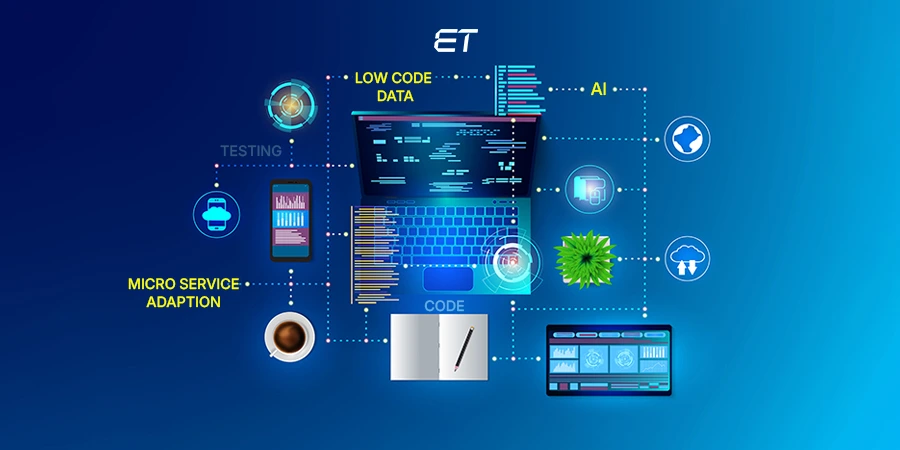
What is the Project Discovery Phase?
If you have ever developed software development projects, one lesson might be clear: the budget exceeds its planned threshold.
In fact, interesting research on large-scale IT projects portrays similar insightful results. On average, IT projects cost 45% over their allocated budget. What’s more? Most of these digital products deliver 56% less value to the end user.
Now, you must be thinking, ‘is there a way to counter these numbers and boost the development process?’
In a word, yes! With a well-implemented project discovery phase, you can deliver a project that adheres to your initial budget and launches as per the scheduled timeline.
This blog explains the meaning of the project discovery phase. As you scroll ahead, you can understand the steps, benefits, and best practices that bolster this vital stage. So, without any ado, let us enlighten you on this important topic that can lead to extravagant project success.
Understanding the Project Discovery Stage

The best IT teams do not initiate the development of a new web portal after one or two meetings. They focus on laying the groundwork for success.
Project discovery is paramount if you want your digital product to stick to your budget without compromising quality.
In simple terms, project discovery is the process of defining the purpose, goals, and feasibility of an IT assignment.
The word, ‘discovery’ portrays this stage’s true meaning.
Your team discovers the need for the project and its chances for potential success in the market. In this phase, you will come across the following steps:
- Problem definition
- Need assessment
- Goal setting
- Feasibility analysis
- Project scope definition
The project discovery phase enables you to avoid costly mistakes in the future. It also ensures every associate understands a specific project’s intent and technical aspects.

Steps in the Project Discovery Phase
You should focus on certain components to implement a successful project discovery phase. Explore this section to understand the necessity of each step and details on proper implementation.
1. Assemble the Team
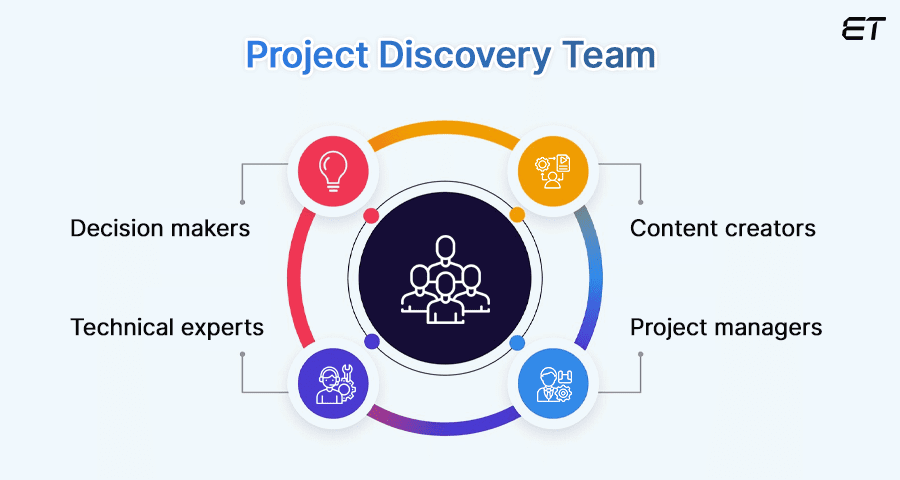
Simple to understand, right?
You need a ‘discovery squad’ to plan the entire project. This discovery team is usually a cross-functional group. The variety in job profiles helps provide different perspectives on a project’s significance.
Experienced software development vendors suggest including the following professionals in your team:
| Stakeholders | User Experience Representative |
| Subject Matter Experts | Content Creator |
| Project Manager | Development Representative |
Note that the team size should be considerable if you have a large or complex project. Also, while assembling a team, ensure you establish the project goals and encourage everyone to share their suggestions.

2. Define the Project Goals

Outlining the desired outcomes of your project requires smart planning. The discovery phase is vital to defining such goals before initiating technical development.
Here are some simple steps to define your IT project’s goals:
- Identify the opportunity
- Consider the needs of the stakeholders and your target audience
- Craft goals that are specific, measurable, achievable, and relevant
- Keep the goals time-bound
Following these simple steps allows you to improve your focus and enhance your decision-making ability. Furthermore, your project discovery phase can help establish measurable outcomes that become the cornerstone of your project.
3. Outline the Expectations

You can consider this step as an extension of the previous one.
However, this software development project step focuses on five key areas:
- Deliverables
- Timelines
- Decision-making
- Communication
- Roles and responsibilities
The following table elaborates on these areas for better understanding.
| Key Area | Explanation |
| Deliverables | What specific outputs do you expect from the discovery phase? This area can include a project charter, user personas, feature outlines, or budget estimate. |
| Timelines | In this section, you should establish a timeframe for completing the discovery phase. Clarity on this segment provides a sense of urgency and helps manage expectations for moving into project execution. |
| Decision-making | You need to form a clear decision-making process during the discovery phase. For instance, it is vital to finalize the personnel responsible for facets like project scope or resource allocation |
| Communication | In this area, you should define how the team will communicate throughout the discovery phase. This decision could involve regular meetings, email updates, or software development collaboration tools. |
| Roles and responsibilities | You should outline the roles and responsibilities of each team member in the discovery phase. This way, you avoid confusion and ensure accountability |
Overall, outlining the expectations can reduce miscommunication, improve productivity, and streamline project execution.
4. Research and Document

This step is a no-brainer in the project discovery phase, don’t you think?
Research is the backbone of discovering your IT project’s ‘why,’ ‘what,’ and ‘who.’ So, you need to conduct the following activities in this step:
- Market research
- User analysis
- Internal evaluation
- Documentation
Conduct surveys and organize interviews of the main personnel for the best results. Also, focus on quality over quantity. Encouraging your team members to participate actively is crucial to gathering relevant information at a brisk pace for the best project initiation.
5. Address Technical Considerations
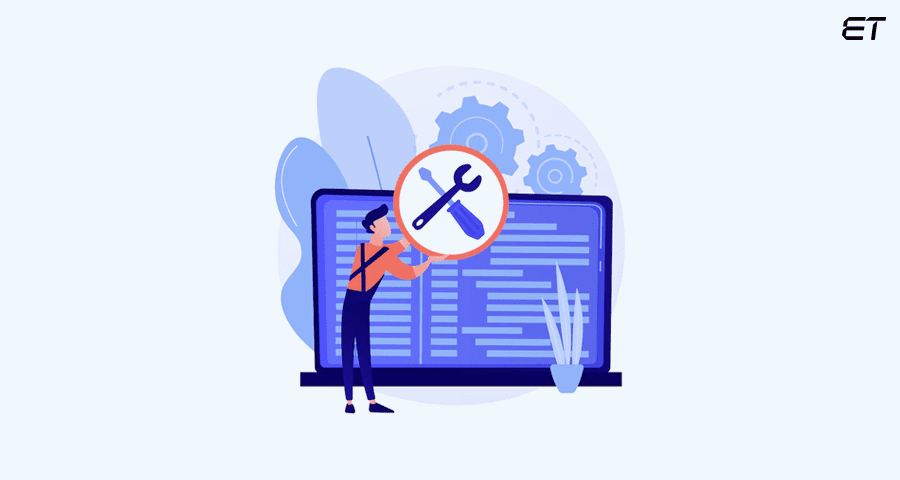
As the name suggests, this step focuses on the following aspects:
- Technology stack: Programming languages, frameworks, and tools
- Tech dependencies: External systems, APIs, integration challenges, etc.
- Scalability: Does your tech stack address this vital attribute
- Technical feasibility: Limitations, potential roadblocks, and budget constraints
- Security considerations: Data protection, user privacy, and adherence to safety regulations
Your main team members in this step are the tech guys. These experts, whether developers, architects, QA engineers, or designers, are crucial for completing this step.
To get the best results, you should evaluate your existing infrastructure. If you notice some talent gap, partner with an IT staff augmentation company to cover all vital facets.

6. Build a Robust Project Plan

The final step in your project discovery phase is formulating a comprehensive plan. What exactly is a project plan?
In simple words, a project plan is a formal document that contains the following sections:
- Scope
- Timeline
- Budget
- Resources
- Communication protocols
These ‘key elements’ should also be supported by a well-thought-out risk management plan. This preliminary assessment is crucial for establishing the mitigation strategies that your team might require later.
In some cases, teams exclude the project plan from the discovery phase. Why?
Well, formulating this document can be time consuming. However, if you include a project plan before the development phase, these benefits are highly probable:
| Why Develop a Project Plan in the Discovery Phase? | |
| To get a clear roadmap for the project | Identifying potential risks and reducing disruptions in the project |
| For cultivating communication and collaboration | To set realistic expectations for resources, outcomes, and timeline. |
Suppose you are not well-versed in formulating a plan. In that case, partnering with an experienced offshore software development company is always a good idea. These organizations have expertise in working on various global projects. Hence, their Project Managers can offer top-quality guidance.
The Advantages of Project Discovery Phase
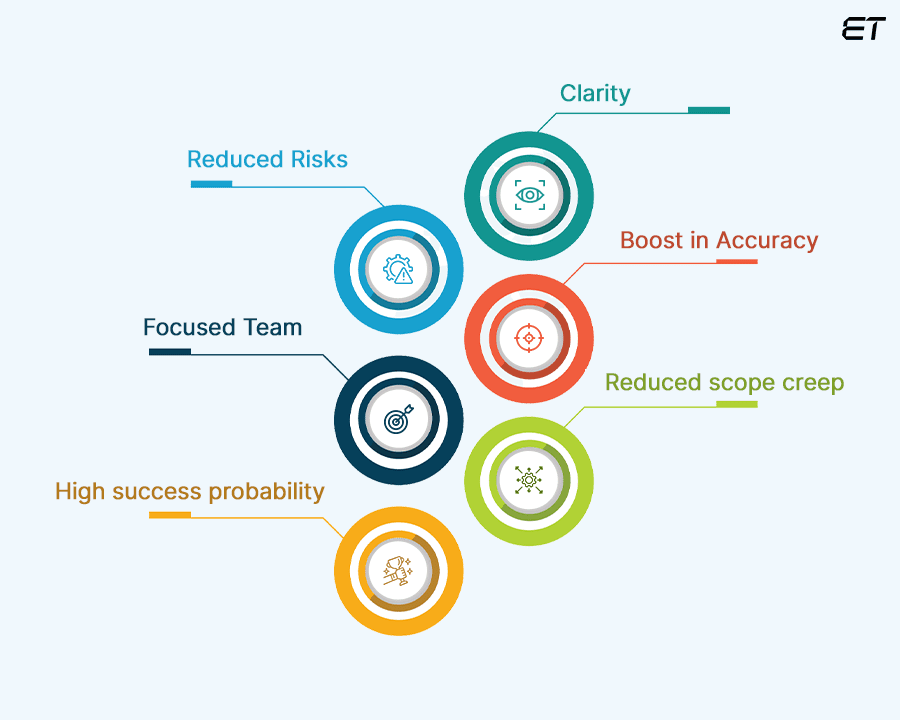
By now, the importance or necessity of the project discovery phase must be clear to you. Starting a project after completing the discovery stage can lead to several benefits.
In this section, we will briefly explain some of the benefits.
Clear Goals and Objectives
Through research, evaluation of user needs, and stakeholder input, the discovery phase helps establish your goals and objectives. A well-defined target keeps everyone on the same page.
So, you can focus on accomplishing the desired outcomes in a more streamlined way.
Low Risks
The discovery phase helps identify potential challenges and areas of uncertainty before initiating a project. This information allows you to develop effective mitigation strategies.
Hence, you and your team can make informed decisions to minimize risks before they derail your project later.
Increased Chance of Accurate Estimates
The discovery phase enables you to better understand the project’s technical feasibility and scope. This knowledge enables you to create more accurate estimates for budget, resources, and timelines.
This benefit helps set realistic expectations for stakeholders and avoids project delays.
Aligned and Focused Team
A team that is clear about the project’s requirement performs more efficiently.
The collaborative nature of the discovery phase promotes communication and alignment within the project team. This aspect leads to smoother collaboration throughout the software development lifecycle.
Decrease in Scope Creep
What is scope creep?
It is the subtle deviation of a project’s development from the original goals due to adding new features. This phenomenon can occur if you do not implement a solid project discovery phase.
Through the discovery stage, you define the project scope upfront and identify potential risks. This way, it is possible to prevent or reduce scope creep.
High Chances of Success
In the end, every person who wants to develop software, a website, or an app wants success, right?
Well, the project discovery phase improves these chances. When you systematically analyze the upfront risks, it becomes easier to prevent mishaps in the later stages.

Want to experience all these benefits? If yes, discuss your requirements and let us collaborate to develop a top-tier project.
A Hypothetical Example
Let us explain how you or your IT vendor can leverage the discovery phase through a simple example.
Overview

Consider a business that has a mobile application for fitness tracking. After launching the minimum viable product in the market, the decision-makers experienced low user engagement and specific issues.
The Solution: A Well-implemented Discovery Phase
This company understood the significance of the project discovery phase. So, they implemented the following steps:
- Assembling a cross-functional team comprising of Product Manager, Data Scientist, UX Designer, and Marketing Representative
- Defining goals through user persona analysis and preliminary feature list
- Conducting weekly team meetings to discuss the insights and storing relevant data in an online collaborative space.
- Organizing user interviews and requesting users to fill survey forms to gain better insights.
- Documenting competitor analysis, user feedback, research findings, and feature list
- Formulating a high-level timeline to revamp the smartphone application.
- Including aspects like fitness forum and social share to bolster the effectiveness of the app.
As you can observe, a systematic project discovery phase became the pivot for revitalizing the fitness app.
The Outcomes
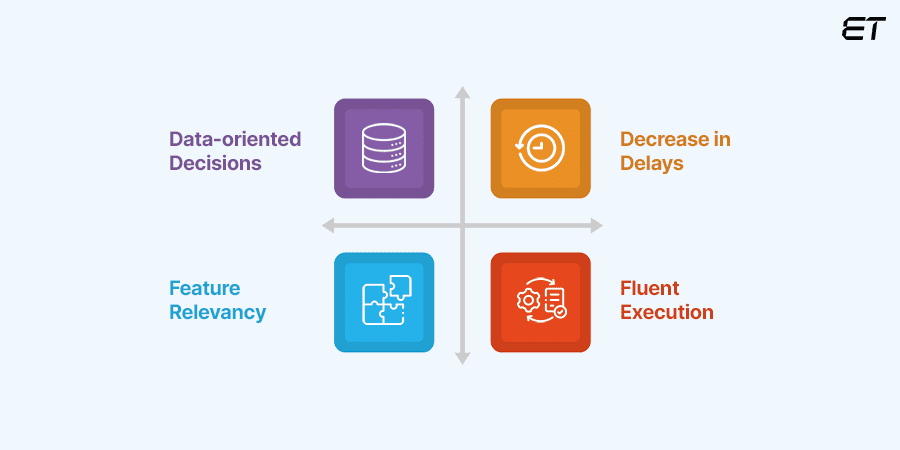
This project discovery phase helped the team to understand valuable user insights. So, they could revamp the application by adding relevant features.
In addition, the team could establish realistic timelines by formulating a clear project roadmap. So, the following benefits were the eventual results of this project discovery phase:
- Data-driven decisions
- Development of more relevant features
- Reduction in development delays
- Smooth project execution
Overall, you can conduct a similar project discovery phase and reap the rewards during the main development.

Interested in unravelling real-life case studies? Check out our recent Case studies and explore our best projects today!
In a Nutshell
A project discovery phase helps establish an IT product’s purpose, goals, tech stack, and feasibility. By performing a systematic discovery segment, you can avoid cost overruns and delayed launches of software, websites, portals, or applications.
You must assemble a multi-level team to conduct a successful project discovery phase. Next, it is essential to define the goals and outline realistic expectations. Research and documentation become crucial in this process.
A good project discovery phase also includes promptly addressing the technology stack and developing a comprehensive plan. By following these steps, you can benefit from increased clarity and focus during the project’s development.
Your team will perform more efficiently as the project’s intention and outcomes are clear. This will allow you to save costs and improve your chances of receiving a high ROI on an IT project.
If you do not have experience implementing project discovery, consider partnering with a reliable IT vendor. On the other hand, if you have a team, it is always beneficial to augment the squad by hiring offshore developers who can help you with this phase.
Frequently Asked Questions
1. What is the meaning of a discovery plan in project management?
A ‘discovery plan’ is an uncommon term in project management. Instead, you can use the phrase ‘project discovery phase,’ which means gathering vital information on a project’s purpose, desired outcomes, feasibility, and technology stack.
2. How long should the project discovery phase last?
The duration of the project discovery phase is subjective and can vary from a couple of days to several months. Your project’s complexity, scope, and available resources influence its duration.
3. What are some red flags in project discovery?
Lack of clear objectives, poor communication, insufficient research, unidentified risks, and disengagement are common red flags in the discovery phase.
4. What are the advantages of spending a good time in the discovery phase?
Investing decent time in the discovery phase minimizes risks, solidifies your project goals, develops a user-centric approach, and sets realistic expectations. All these factors increase the chances of delivering a successful software project.



